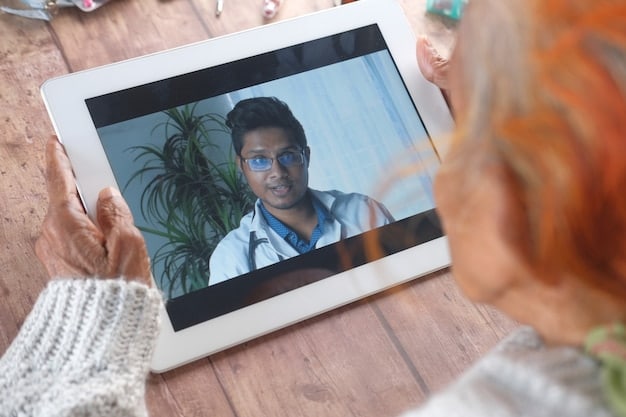Digital Transformation in Healthcare: Telemedicine and Access for More Patients

Digital transformation in healthcare, particularly through telemedicine, is poised to revolutionize patient access, potentially improving it for 30% more patients by offering convenient, remote, and efficient care solutions.
The landscape of healthcare is rapidly evolving, and at the forefront of this change is the **impact of digital transformation on healthcare: How will telemedicine improve access to care for 30% more patients?** This shift promises not just incremental improvements, but a fundamental reshaping of how healthcare is delivered and accessed and its growing impact.
Understanding Digital Transformation in Healthcare
Digital transformation in healthcare involves integrating digital technology into all aspects of the industry, fundamentally changing how it operates and delivers services. This transformation promises streamlined processes, better patient outcomes, and cost efficiencies.
Key Components of Digital Transformation
The core of digital transformation in healthcare hinges on several pivotal components. These technologies collectively enhance the efficiency, accessibility, and quality of healthcare services.
- Electronic Health Records (EHRs): Digital versions of patients’ paper charts, providing real-time, patient-centered records that make information available instantly and securely to authorized users.
- Telemedicine: The use of telecommunications and information technology to provide clinical care remotely, offering consultations, monitoring, and education via video conferencing, mobile apps, and wearable devices.
- Artificial Intelligence (AI) and Machine Learning: Enhancing diagnostic accuracy, personalizing treatment plans, and predicting patient outcomes through advanced data analysis.

Benefits of Digital Transformation
Digital transformation offers a wealth of advantages, transforming how healthcare is delivered and experienced. These benefits span from improving patient care to streamlining operational efficiencies.
- Improved Patient Access: Telemedicine and digital tools eliminate geographical barriers, enabling more individuals to receive care, especially in underserved areas.
- Better Patient Outcomes: Enhanced access to information, AI-driven diagnostics, and personalized treatment plans all contribute to improved health outcomes.
- Increased Efficiency: Streamlining administrative tasks, reducing paperwork, and automating processes enable healthcare providers to focus more on patient care.
In summary, digital transformation is revolutionizing healthcare by enhancing efficiency, improving patient outcomes, and increasing accessibility. As technology continues to evolve, its role in healthcare will only become more critical.
The Rise of Telemedicine
Telemedicine has emerged as a cornerstone of digital transformation in healthcare, offering a convenient way for patients to connect with healthcare providers remotely. This approach has profound implications for expanding access to care, particularly for underserved populations.
What is Telemedicine?
Telemedicine encompasses various technologies and methods used to provide healthcare services remotely. It’s a comprehensive approach that leverages digital tools to enhance patient care.
- Virtual Consultations: Real-time video calls with doctors, specialists, and other healthcare providers for diagnosis, treatment planning, and follow-up care.
- Remote Monitoring: Using wearable devices and mobile apps to track vital signs, medication adherence, and other health metrics, allowing for timely interventions.
- Store-and-Forward: Sharing medical information, such as images and lab results, electronically with specialists for consultation and diagnosis.
Telemedicine and Increased Access
One of the most significant impacts of telemedicine is its ability to overcome geographical barriers, making healthcare accessible to more people. This advantage is particularly crucial for those in rural or underserved communities.
- Rural Access: Telemedicine bridges the healthcare gap in rural areas where access to specialists and medical facilities is limited.
- Convenience: Patients can receive care from the comfort of their homes, eliminating the need for travel and reducing wait times.
- Cost-Effective: Lower travel costs and reduced hospital readmissions can make healthcare more affordable for both patients and providers.
Telemedicine is revolutionizing access to healthcare by removing geographical barriers, offering convenience, and reducing costs. As technology advances, its role in improving healthcare delivery will continue to expand.
How Telemedicine Can Improve Access by 30%
The promise of telemedicine to improve access to care for 30% more patients is not just aspirational; it’s grounded in practical applications and data-driven projections. Several factors contribute to this potential for significant improvement.
Reaching Underserved Populations
Telemedicine has the potential to drastically improve healthcare access for traditionally underserved populations. By bringing care directly to individuals in their homes, it breaks down barriers and ensures more equitable access.
- Geographical Barriers: Telemedicine eliminates the need for patients in remote areas to travel long distances to see a doctor, providing timely care when they need it.
- Socioeconomic Factors: Reduced travel costs and time off work make healthcare more accessible for low-income individuals.
Enhancing Chronic Disease Management
Chronic diseases require continuous management, and telemedicine offers innovative ways to monitor and support patients effectively. This is especially beneficial for conditions that necessitate frequent check-ups and adjustments.
Telemedicine offers versatile benefits for managing and preventing chronic diseases effectively. For example, remote monitoring devices allow real-time tracking of vital signs, enabling timely medical intervention and personalized care plans.
Reducing Healthcare Costs
Telemedicine can significantly reduce healthcare costs by preventing hospital readmissions, improving medication adherence, and minimizing unnecessary emergency room visits.

By reducing healthcare costs, preventing hospital readmissions, and improving medication adherence, telemedicine enables healthcare systems to allocate resources more efficiently and provide better care.
Telemedicine has the potential to vastly improve healthcare access by reaching underserved populations, enhancing chronic disease management, and reducing healthcare costs. Its ability to overcome traditional barriers makes it a pivotal tool for transforming healthcare delivery.
Overcoming Challenges in Telemedicine Implementation
While telemedicine offers immense potential, its widespread adoption faces several challenges that must be addressed to realize its full benefits. These challenges range from technological barriers to regulatory and reimbursement issues.
Technological Barriers
Reliable internet access and digital literacy are essential for telemedicine to be effective. However, these are not uniformly available, creating disparities in access.
- Internet Access: Many rural and low-income areas lack reliable internet access, making telemedicine inaccessible to those who could benefit most.
- Digital Literacy: Some patients, especially older adults, may lack the skills to use telemedicine technologies effectively.
Regulatory and Reimbursement Hurdles
Inconsistent regulations across states and inadequate reimbursement policies can hinder the adoption of telemedicine. Addressing these issues is crucial for ensuring sustainable growth.
Inconsistent regulations and the absence of uniform standards across different states create uncertainty and make it challenging for healthcare providers to offer telemedicine services.
Data Security and Privacy Concerns
Protecting patient data is paramount in telemedicine. Robust security measures and adherence to privacy regulations are essential to maintain trust and ensure responsible use of technology.
Protecting patient data involves implementing encryption, secure data storage, and stringent access controls to ensure the confidentiality and integrity of medical information.
Overcoming challenges in telemedicine implementation requires addressing technological barriers, regulatory and reimbursement hurdles, and data security concerns. By tackling these issues head-on, we can unlock the full potential of telemedicine and improve healthcare access for all.
Success Stories and Case Studies
Real-world examples of telemedicine are providing compelling evidence of its ability to improve access to care and enhance patient outcomes. These success stories illustrate the transformative impact of telemedicine across various healthcare settings. These successful case studies emphasize the diverse and practical benefits telemedicine offers, from enhancing chronic disease management to delivering timely interventions in remote areas.
Telemedicine in Rural Communities
Telemedicine programs in rural areas have demonstrated remarkable success in improving access to care. These initiatives often involve mobile clinics and remote monitoring devices to reach patients who would otherwise go without care.
The success of telemedicine initiatives in rural communities lies in their ability to provide specialist consultations, primary care services, and chronic disease management support to patients, enhancing their overall well-being.
Telemedicine for Chronic Disease Management
Telemedicine has proven to be highly effective in managing chronic conditions. Remote monitoring and virtual consultations enable healthcare providers to closely track patients’ health and make timely interventions.
By empowering patients to manage their conditions more effectively from home, telemedicine has led to reduced hospital admissions, improved adherence to treatment plans, and enhanced quality of life.
Telemedicine in Mental Health Services
Telemedicine has transformed mental health services by offering convenient and confidential access to therapy and counseling. Video conferencing allows patients to connect with mental health professionals from the comfort of their homes.
Studies have shown that telemedicine can be just as effective as in-person therapy for treating conditions like depression, anxiety, and PTSD, providing a lifeline to those who may not otherwise seek help.
Success stories and case studies underscore the transformative potential of telemedicine. As technology continues to evolve, these examples provide valuable insights into how telemedicine can be leveraged to improve healthcare access, enhance patient outcomes, and reduce costs.
The Future of Telemedicine
Looking ahead, the future of telemedicine is poised for continued growth and innovation. As technology advances and healthcare needs evolve, telemedicine will play an increasingly central role in delivering care.
Advancements in Telemedicine Technology
Emerging technologies are set to revolutionize telemedicine, enhancing its capabilities and expanding its applications. These advancements promise to make telemedicine even more accessible, efficient, and effective.
- Artificial Intelligence (AI): AI-powered tools can assist in diagnosis, treatment planning, and patient monitoring, improving the accuracy and efficiency of telemedicine consultations.
- Virtual Reality (VR): VR technology can be used for pain management, rehabilitation, and mental health therapy, offering immersive and engaging experiences for patients.
- Wearable Devices: Advanced wearable sensors may provide continuous data on vital signs, sleep patterns, and activity levels, helping healthcare providers monitor chronic conditions and personalize care effectively.
Policy and Regulatory Changes
Favorable policy and regulatory changes are essential to support the growth of telemedicine. These changes can address issues such as reimbursement, licensing, and data privacy, creating a more favorable environment for telemedicine adoption.
By establishing clear, consistent, and supportive regulations, policymakers can encourage healthcare providers to invest in telemedicine technologies and integrate them into their practices, ensuring access for patients across all demographics.
Telemedicine as a Standard of Care
As telemedicine becomes more integrated into healthcare systems, it has the potential to become a standard of care. This shift would involve telemedicine being routinely offered as a viable option for a wide range of medical needs.
- Expanded Access: Telemedicine ensures that people have access to healthcare services, whether they are in rural areas, living with disabilities, or have limited mobility.
- Improved Convenience: Patients may book telemedicine appointments for their healthcare needs, eliminating the need to travel to a medical facility, and enabling them to receive care with ease and comfort.
The future of telemedicine is bright, with ongoing advancements in technology, support for favorable policy and regulatory changes, and the potential of telemedicine to become a standard of care. As these new opportunities emerge, they promise to improve healthcare access and patient outcomes.
| Key Point | Brief Description |
|---|---|
| 🚀 Telemedicine Access | Improves healthcare access by eliminating geographical barriers. |
| 💰 Cost Reduction | Reduces healthcare costs through fewer hospital readmissions. |
| 🩺 Chronic Management | Enhances chronic disease management with remote monitoring. |
| 🔒 Data Security | Focus on ensuring data security while using telemedicine to protect and respect patient privacy. |
Frequently Asked Questions
▼
Telemedicine eliminates the need for long travel distances by offering virtual consultations with healthcare providers from the comfort of home. This helps the patients receive timely care without geographical barriers.
▼
Telemedicine reduces costs by eliminating travel expenses, minimizes hospital readmissions through efficient remote monitoring, and reduces the need for expensive emergency room visits for general medical care.
▼
Remote patient monitoring utilizes wearable devices and mobile apps to track vital signs and help report to healthcare providers. This technology enables healthcare providers to make timely interventions, thus improving patient outcomes.
▼
Telemedicine data security measures include encryption, secure data storage, and compliance with HIPAA regulations. These robust measures keep medical information private and secure during transmissions between patients and providers.
▼
AI in telemedicine improves diagnostic accuracy through advanced data analysis. AI facilitates personalized treatment plans based on data, and predicts health outcomes, enabling more efficient patient care and reducing reliance on humans.
Conclusion
In conclusion, the digital transformation of healthcare through telemedicine is poised to revolutionize patient access, potentially improving it for 30% more patients. As technology advances and regulatory support grows, telemedicine will play an increasingly vital role in healthcare delivery, ensuring more people receive timely, convenient, and high-quality care.





